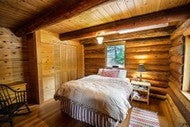Rustic vs. Farmhouse Décor: What's the Difference and Which is Preferable?
Apr 15th 2021
 Rustic and farmhouse styles are similar, but where rustic is rougher and leans toward neutral hues, farmhouse favors whitewashing and more refined natural elements.
Rustic and farmhouse styles are similar, but where rustic is rougher and leans toward neutral hues, farmhouse favors whitewashing and more refined natural elements.
Some homeowners are interested in contemporary design, including clean lines, minimalist décor, and spartan sensibilities. Others prefer the overstuffed furniture and ornate embellishments common to traditional styles like French or Victorian interiors. If you're looking for something simple, yet warm and inviting, you're sure to appreciate rustic or farmhouse style décor.
While these two country styles share some similarities, including natural elements like wood and plenty of natural light, they can be differentiated in a few key ways. How can you tell the difference between rustic and farmhouse design, and which is right for your home?
Rustic Décor
Merriam Webster defines the word rustic, in terms of furniture, as "made of the rough limbs of trees," and it turns out this is also a defining characteristic of the rustic style. While both rustic and farmhouse styles rely heavily on wooden elements, the former leans toward a rougher, more natural appearance, with less shaping, sanding, staining, and other alterations to the natural piece. This creates an aesthetic akin to being in nature—an authentic, woodsy vibe.
Rustic décor could also include rough-hewn textiles in natural fibers (cotton, hemp, wool, etc.), as well as natural elements like stone, although brick is also acceptable. Rough, stone fireplaces, weathered wood flooring, and furnishings made from tree stumps and branches are all de rigueur for the rustic style. Neutral colors allow the natural materials in the environment to bring color and life to your design.
Farmhouse Décor
While rustic décor strives to highlight items as close to their natural state as possible, farmhouse design takes a slightly different approach. It relies on natural materials, but doesn't shy away from honing them to create a fresh, clean aesthetic.
Wood elements are typically machine cut, sanded, and polished. Often, they're still nude or stained, as opposed to painted, so the natural grain is on full display. In other words, this style is still natural, but more refined.
Whitewashed interiors provide a bright backdrop for natural elements, which bring warmth to the environment. Wood is not used sparingly. It's normal to see wooden flooring, cabinets, beams, and of course, plenty of wooden furniture. Textiles may be natural, but they needn't be neutral, often featuring colors, patterns, and elements like scenery.
Which is Right for You?
Rustic and farmhouse styles may have similar core values, but the way natural elements are used is very different. You'll simply have to decide if you want your home to feel like a never-ending campout, or if you prefer a brighter, more refined take on simple, country styling.

